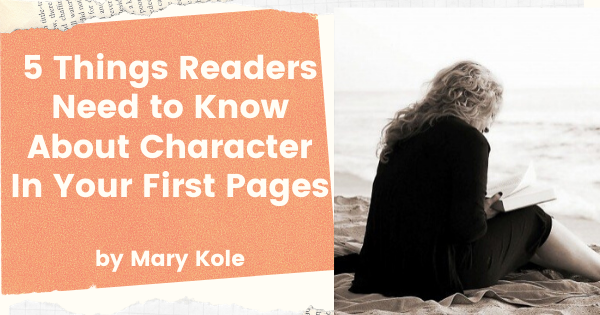By Mary Kole, Good Story Company, @kid_lit
For the last ten years, I’ve been teaching all about characterization: what writers can do to flesh out their characters. As a former literary agent, I also know the importance of first pages. So I thought I’d put the two together: how to best characterize your protagonist in the first pages of your manuscript. Make no mistake, readers bond with character first. I truly believe that character is a reader’s lens into story. So if you don’t hook your reader (or agent, or publisher) quickly, they may not stick around to see if it “gets good later.”
Here’s what readers will want to know about your character right away:
- Something nice: Even if your character is rough around the edges, they will need to prove themselves as someone worth following for the next few hours. Take a cue from Save the Cat by Blake Snyder and weave in an opportunity for your protagonist to show their nice side, even if nobody else sees it. For all their potential flaws, your character needs to demonstrate some fundamental goodness with a kind word or gesture.
- Something secret: Readers love vulnerability. It feels true and honest and we can all relate to it. Nobody else in your story world needs to know your protagonist’s vulnerable underbelly, but readers must. Vulnerability is best delivered in your character’s interiority (their thought process), and ideally, it will have to do with the character’s inner struggle or goal (see below).
- Something stormy: Inner struggle is a huge part of what makes a character interesting. Usually, our inner struggle is internal conflict that stems from something in our past or our present that we don’t like. Whether it’s a conflict with self, like wanting to feel accepted, or a conflict with others, like needing validation from a partner, this is the sand in the bottom of our shoe. Your character should have something that frustrates them, because this creates conflict and tension. Those are the engines of story. You should, of course, develop an engaging external plot in addition to this, but giving character something that bothers them is a good way of keeping conflict high throughout.
- Something past: I wouldn’t recommend starting your story with a strong eye toward the past. Flashbacks and info-dumping in your first few pages are a big no-no. However, it’s wise to plant some seeds of past tense as a way of informing present tension. Is there a big event in the past—whether it’s distant past or recent past—that haunts your character and drives their present action? Let readers know about it, even if it’s a quick mention. Now they will be eager to learn more, and you will explore it further when the time comes.
- Something future: Perhaps the most important thing to introduce about your character right away is their object, or what they want. This will drive them throughout the story, and it’s infinitely relatable. We all know what it’s like to want or need something. By setting up a clear objective, you are sending a signal to your reader: This goal is what will drive this character, and this will be a great source of tension throughout. After that, readers will be eager to know whether your protagonist achieves their objective or not.
Putting all of this data into your first few opening pages might seem daunting. Remember, the enemy of dynamic first page action is information. Try to deploy as much of these five things in action, dialogue, or reaction, if possible. You should be starting your story in scene or with forward momentum anyway.
If you launch into your manuscript with strong character, readers will “go there” and dive headfirst into your compelling story.
 As a former literary agent, I know the ins and outs of the publishing industry firsthand. Now, I focus on—simply—helping writers craft a good story. I founded Mary Kole Editorial in 2013 and provide consulting and developmental editing services to writers of all categories and genres, working on children’s book projects from picture book to young adult, and all kinds of trade market literature, including fantasy, mystery, sci-fi, romance and memoir. I founded Good Story Company in 2019 with the aim of providing valuable content—like the Good Story Podcast and Crit Collective writing forum—to writers of all categories and ability levels.
As a former literary agent, I know the ins and outs of the publishing industry firsthand. Now, I focus on—simply—helping writers craft a good story. I founded Mary Kole Editorial in 2013 and provide consulting and developmental editing services to writers of all categories and genres, working on children’s book projects from picture book to young adult, and all kinds of trade market literature, including fantasy, mystery, sci-fi, romance and memoir. I founded Good Story Company in 2019 with the aim of providing valuable content—like the Good Story Podcast and Crit Collective writing forum—to writers of all categories and ability levels.
On the craft side, I hold an MFA in Creative Writing and have worked at Chronicle Books, the Andrea Brown Literary Agency, and Movable Type Management. I’ve been blogging at Kidlit.com since 2009. My book, Writing Irresistible Kidlit, a writing reference guide for middle grade and young adult writers, is available from Writer’s Digest Books.
5 Things Readers Need to Know About Character In Your First Pages (by @kid_lit ): Share on XSocial Links
Company: https://goodstorycompany.com
Editing: https://marykole.com
Blog: https://kidlit.com
Podcast: https://goodstorypodcast.com
Forum: https://critcollective.com
Facebook: https://facebook.com/goodstoryco
Facebook: https://facebook.com/marykoleeditorial/
Twitter: https://twitter.com/goodstoryco
Twitter: https://twitter.com/kid_lit
Instagram: https://instagram.com/goodstorycompany
YouTube: http://bit.ly/ytgoodstory
Submission Course: https://bit.ly/kolesub
Book: http://bit.ly/kolekidlit
Photo on Visualhunt

Save the Cat! Great book.
As I am working on edits now, I can see where I need a little more past and present in the first few pages.
Isn’t it? Really helpful, I think.
I like this way of looking at character development. Most people are more than they seem on the surface. So, a character with different sides feels more realistic. Giving readers a look at a character’s various sides invites them to care what happens to that character. And, to me, that’s what encourages them to engage with the story.
I completely agree! Glad you think so.
Thanks for the post, Mary! Such an important topic.
Wonderful tips and perfect timing, as I’m working on a new opening for my novel. Thank you!
Excellent tips. Thanks for sharing!
Great advice! Thanks!